hnlzm@lvmeikapton.com
+86 13787123465


Hunan Lvzhimei New Material Technology Co., Ltd.


NameDescriptionContent
What are the performance requirements for high-temperature tapes in the automotive manufacturing field?
Source:
|
Author:lvzhimei
|
Published time: 2025-02-10
|
142 Views
|
Share:
The automotive manufacturing industry has numerous stringent requirements for the performance of high - temperature tapes, which are mainly reflected in the following aspects:
High - Temperature Resistance
During the automotive production process, in processes such as the drying stage after painting and the high - temperature assembly environment of components like the engine, the temperature usually reaches 100°C - 200°C or even higher. High - temperature tapes need to maintain stable performance under such high - temperature conditions, without melting, deforming, embrittling, etc., to ensure that they can properly perform functions such as masking and fixing.
During the vehicle's operation, parts such as the engine compartment are in a high - temperature environment for a long time. High - temperature tapes must be able to withstand the high temperature generated during the engine's operation. For example, when exposed to an environment of 120°C - 150°C for an extended period, they should still maintain their adhesion and physical properties, without issues such as adhesive failure and aging.
Adhesion and Bonding Performance
Initial Adhesion
During the automotive manufacturing assembly process, high - temperature tapes need to be able to quickly adhere to the surface of components. Even on curved or uneven surfaces, they can attach rapidly, serving functions such as temporary fixation and ensuring the convenience and efficiency of operations.
Holding Adhesion
During the high - temperature processes in automotive production and the vehicle's service life, high - temperature tapes should maintain good adhesion over a long period, firmly connecting the bonded components together. They should not fall off due to factors such as vibration and temperature changes. For instance, when fixing engine components, they need to withstand the engine's vibration and high temperature throughout the vehicle's lifespan to keep the components stably connected.
Peel Strength
On one hand, after processes such as automotive painting are completed, the high - temperature tape should be able to be cleanly peeled off from the surface of components such as the vehicle body without leaving any adhesive residue, so as not to affect the vehicle body's appearance and subsequent assembly processes. On the other hand, for parts that require long - term bonding, such as the bonding of interior components, the tape should have sufficient peel strength to ensure that the interior components do not easily fall off during the vehicle's operation.
Chemical Resistance
A variety of chemical substances are used in the automotive manufacturing process, such as paints, coatings, solvents, and cleaning agents. High - temperature tapes need to have good chemical resistance. After coming into contact with these chemical substances, they should not undergo chemical reactions, nor should there be a decrease in adhesion or damage to the tape material, ensuring that their performance remains unaffected.
During the vehicle's operation, high - temperature tapes may come into contact with automotive fluids such as engine oil, coolant, and brake fluid. They must be able to resist the erosion of these fluids, maintain their physical and chemical properties stable, and prevent tape failure due to contact with these fluids.
Mechanical Properties
Flexibility
Automotive components come in a wide variety of shapes and surface geometries. High - temperature tapes should have good flexibility, enabling them to fit well on the surfaces of irregular - shaped components such as curved parts of the vehicle body and complex structural components of the engine. This ensures close contact between the tape and the components, improving the bonding effect and protective performance.
Tensile Strength and Abrasion Resistance
During the automotive manufacturing process, high - temperature tapes may be subjected to a certain degree of tension and friction. For example, when bundling wire harnesses or fixing components, the tape needs to have sufficient tensile strength to withstand a certain amount of pulling force without breaking. At the same time, during the vehicle's operation, the tape may rub against other components, so it needs to have good abrasion resistance to ensure the integrity and performance stability of the tape.
Insulation Performance
The automotive electrical system is complex. When high - temperature tapes are used for wrapping wire harnesses and protecting electronic components, they must have excellent insulation performance to effectively prevent current leakage and avoid short - circuits between wires, ensuring the safe operation of the automotive electrical system and the safety of the vehicle and passengers.
In strong electromagnetic environments such as the engine, high - temperature tapes should also have certain electromagnetic shielding properties to prevent external electromagnetic interference from affecting the normal operation of electronic devices, and at the same time, avoid electromagnetic radiation from internal electronic devices interfering with other components.
Environmental Performance
With the continuous increase in environmental requirements, the automotive manufacturing industry also has strict requirements for the environmental performance of high - temperature tapes. The tapes should comply with relevant environmental standards, such as the EU's RoHS directive, and should not contain harmful substances such as lead, mercury, cadmium, and hexavalent chromium, avoiding harm to the environment and human health during automotive production and use.
When a vehicle is scrapped and recycled, high - temperature tapes should have good degradability or recyclability, facilitating the recycling and treatment of automotive parts and reducing environmental pollution.

Hunan Lvzhimei New Material Technology Co., Ltd.
Quick Links
Product Categories
© 2024 Hunan Lvzhimei New Material Technology Co., Ltd.All Rights Reserved. Designed by Erge
0731 - 89717319
hnlzm@lvmeikapton.com
+86 13787123465
Room 502, Chuangye Building, No186, Guyuan Road, High-Tech District, Changsha, Hunan, China
CONTACT




